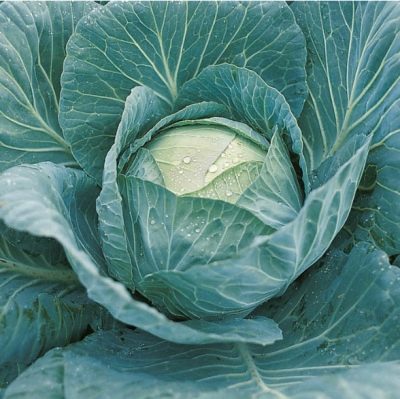
- Authors: Bejo Zaden, Holland
- Name synonyms: Krautkaizer
- Year of approval: 1993
- Appointment: for fresh consumption, for fermentation, for all types of processing
- Leaf rosette: raised
- Leaf size: medium size
- Leaf color: blue-green
- Outside stump: short
- Internal stump: middle length
- Weight, kg: 3,2-4,8
Cabbage is one of the main vegetables on our table, because you can cook a huge number of dishes from it. And many more want the variety to have excellent taste, so that it is well stored and universal. This is the Krautkayser variety.
Breeding history
This variety was bred in the last century. In the 90s in Holland, breeders worked on a variety that would be close to universal. The experiment patent was given to Bejo Zaden B. V. In 1993 the variety was included in the Russian Register.
Description of the variety
It is a hybrid that is best cultivated in the temperate zone. The culture features a powerful and sturdy rosette that is compact in appearance. Moreover, there are relatively few leaves in the head of cabbage.
The leaf plates are small, ovoid, the edges are without characteristic notches, but with slight wrinkles. The leaves are colored bright green with a slightly bluish tint, the entire surface of the leaf plate is coated with a wax-like coating.
Characteristics of the appearance of the plant and heads of cabbage
Heads of cabbage are almost always small, but even in shape, with a dense structure. The section shows that the vegetable culture is juicy, its inner part is painted in white shades, and the outer part is green. The stump is common, and the head of cabbage has a flat-oval shape. The average weight of a head of cabbage is 3.2-4.8 kg.
Purpose and taste
It is grown both as mechanical processing (salads, canning, pickling) and for fresh consumption. But the shelf life of Krautkaiser is short, up to 4 months. Well suited for industrial cultivation. Sometimes, due to its excellent juiciness, the variety is used to make cabbage juice. It is useful in raising immunity, because the culture has a huge content of vitamin C.
Many gardeners note the worthy taste of the culture.
Ripening terms
Krautkaiser is a mid-late crop, closer to late ripening. In some areas, it is ready for use after 139 days from the date of sowing the seeds. Of course, it all depends on the weather, sometimes ripening is delayed for 150 days.
Yield
It is a high-yielding variety. With proper agricultural technology, yields can reach from 574-1055 centners per hectare.
Growing regions
The variety is successfully cultivated in many regions and regions of Russia:
- Far East;
- Northwest;
- Uralsk;
- North;
- East Siberian;
- Central;
- West Siberian;
- Volgo-Vyatsky;
- Nizhnevolzhsky.
The list shows that the geography of cultivation is quite extensive.
Growing and care
Growing and nursing have their own subtleties. The vegetable does not like dryness. During the entire growth period, cabbage must be watered abundantly, but no stagnation of water masses should be allowed. Therefore, in the cultivation of "crispy" vegetables, you need to adhere to some rules:
- constant loosening of the soil;
- fertilizing several times per season;
- correct watering.

To grow a rich cabbage crop, you need to know when and how to plant this crop outdoors. Planting dates are determined depending on the variety. It is also necessary to properly prepare the soil and follow the rules of crop rotation.


Soil requirements
A loose, nutritious, neutral soil is perfect for a vegetable crop. The ideal option is loam or black soil. During the season, you can add compost or humus under the head of cabbage.

Cabbage requires particularly careful care when growing. The plant quickly absorbs nutrients, so the soil needs to be enriched regularly. Adequate amounts of minerals, organics and nitrogen must be provided. Some products can be purchased at the store, while others are easy to make at home.
Required climatic conditions
Based on the geography of growth, any climatic conditions are suitable for growing cabbage. The only caveat: in places with a cool or humid climate, the ripening period shifts upward.
Disease and pest resistance
This variety has a fairly high resistance to diseases and parasites. But incidents do happen. For example, some viral infections, peronosporosis or keela may appear. Among the pests, aphids, cruciferous flea, and some types of caterpillars can be disturbed.
As a preventive measure, it is necessary to properly care for the crop: loosening, watering, soil selection, fertilizing, weeding.

Cabbage is a very popular horticultural crop. But growing a good, large and tasty cabbage is sometimes very difficult, because it is often affected by a huge number of diseases and pests. The main role in the cultivation of this vegetable is played by regular prevention, which helps to get a rich harvest, and prevent the occurrence of diseases and the invasion of harmful insects. It is very important to start treatment as early as possible, otherwise there is a risk of spreading the infection to still unaffected plants.
Review overview
Gardeners who have planted a vegetable on their plots more than once note some positive qualities of the culture. Especially many people like it when fermented, although this is not a completely late variety.
Users also note the taste: juiciness, tenderness, the absence of coarse and hard veins. As well as excellent germination and excellent yield even in the driest times.
The housewives say that the head of cabbage does not lean, and the leaves do not grow so magnificently. Therefore, under the head of cabbage it is always moderately dry, there is no dense vegetation, flocks of slugs and other insects do not gather there.
But many summer residents are upset that cabbage is not stored for a long time. Although excellent preservation, salting and fermentation are obtained from it.
Judging by the reviews and varietal characteristics, such a vegetable can be safely grown on your personal plot.























































































